| View previous topic :: View next topic |
| Author |
Message |
Pat Anderson
Joined: 02 Nov 2003
Posts: 8553
City/Region: Birch Bay, WA
State or Province: WA
C-Dory Year: 2005
C-Dory Model: 25 Cruiser
Vessel Name: Daydream
Photos: Daydream and Crabby Lou
|
 Posted: Sat Dec 29, 2007 4:21 pm Post subject: Batteries - Again / Still Posted: Sat Dec 29, 2007 4:21 pm Post subject: Batteries - Again / Still |
 |
|
Our starting battery on Daydream (Optima Blue Top SC34M), which I thought was charged from the indicator light on the on-board Guest charger (5/5 - a definite upgrade project is in order here), did not have enough juice to even lower the outboard, let alone start it...so we depended on our two house batteries (Optima Blue Top SC34DM) for starting and running everything (battery switch to "emergency parallel" position), which was not a problem on an overnighter. I pulled the starting battery and have it on a Schumacher 10 amp charger right now, we'll see in a few hours if it even takes a charge. I don't really have the know-how to load test it if it does take a charge, I guess I could take it to Les Schwab. I am assuming it is toast though.
My topic really is what batteries SHOULD we have? These are the batteries that C-Dory installed when we bought the boat in 2005. I will be kind of disappointed if the starting battery has failed after only two years, but apparently other folks here have had similar experience with these Optima Blue Tops. Here is what the specs are on these batteries - what would others recommend for replacement?
Starting Battery (1)
SC34M - Model SPR, CCA 800, AH 50, RC 110
House Batteries (2)
SC34DM, Model SPR, AH 55, RC 120
It seems we have 110 amp hours in our house batteries, I know you only have a percentage of nominal amp hours, but they have never let us down. But we probably need to replace the starting battery, and who knows how long the house batteries will go? So if you were going to replace these three batteries, what would you go with? We are cruisers, maybe overnight, maybe to Alaska...running GPS, VHF, Wallas, lights, stereo, window fans, Airhead fan, refrigerator, maybe laptop on the inverter, can't afford to have the batteries let us down!
_________________
DAYDREAM - CD25 Cruiser
CRABBY LOU - CD16 Angler (sold 2020)
Pat & Patty Anderson, C-Brat #62!
http://daydreamsloop.blogspot.com
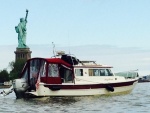
Last edited by Pat Anderson on Sun Dec 30, 2007 7:39 am; edited 1 time in total |
|
| Back to top |
|
 |
Sea Wolf
Joined: 01 Nov 2003
Posts: 8650
City/Region: Redding
State or Province: CA
C-Dory Year: 1987
C-Dory Model: 22 Cruiser
Vessel Name: Sea Wolf
Photos: Sea Wolf
|
 Posted: Sat Dec 29, 2007 5:19 pm Post subject: Posted: Sat Dec 29, 2007 5:19 pm Post subject: |
 |
|
Pat-
Sorry to hear about your dead battery!
What to recommend?
Well, being basically cheap (or, more politely, economy oriented) I simply go to Wal Mart and buy their giant Marine Deep Cycle Group 27 105 AH batteries that cost about $60 each and seem to last 4 -6 years for me, at least.
I do know about starting batteries, dual-purpose batteries, deep cycle batteries, gel-cell and AGM batteries, etc, but the big deep-cycle marine batteries have never failed me if properly charged and maintained, a least until it's time for them to fly away to Battery Heaven.
The big deep cycle marine batteries have plenty of cranking amps for any outboard motor, are ideally suited for house use, and, in addition, are hard to damage because of their deep cycle design.
I know there are advantages to gel cell and AGM batteries, but since I'm not planning on flying upside down, why spend $200 on a battery that puts out far less Amp-Hours than a $60 deep cycle marine battery?
Another plus is that Wal-Mart (or the equivalent like Costco), has a very good warrantee policy which they honor without question.
The only down side I can think of to going over to these big babies of the battery world is that you might have to get bigger battery boxes to house them and they'll weigh quite a bit more than your old batteries (maybe 20 lbs each).
I keep the electrical supply simple. No two or three part starting, house, and back up battery systems.
I use four group 27 deep cycle batteries that can be connected in parallel to give a 420 AH battery to do everything electrical in my C-Dory. No isolators, combiners, multiple charging circuits, etc. KISS rules in my electric system. I never have run a battery down. A few have failed when their time has come. So be it.
You've got a Honda 2000i generator, it can be used to charge any battery that you run down. Your safety net is in place.
Others may have different ideas, and I'd like to hear them. For me, sheer battery power outweighs complex battery systems that very few can understand, maintain, or repair.
Having fun with your question!
Joe.  
_________________
Sea Wolf, C-Brat #31
Lake Shasta, California
  
"Most of my money I spent on boats and women. The rest I squandered'. " -Annonymous |
|
| Back to top |
|
 |
ccflyer
Joined: 19 Sep 2005
Posts: 391
City/Region: Bradenton, FL
State or Province: FL
C-Dory Year: 2003
C-Dory Model: 22 Cruiser
Vessel Name: Retriever
Photos: ccflyer
|
 Posted: Sat Dec 29, 2007 6:00 pm Post subject: Posted: Sat Dec 29, 2007 6:00 pm Post subject: |
 |
|
I'd be interested in knowing how you can determine if a battery should be replaced as part of a PM program. Personally, I'd rather put in a new one at the beginning of the season than find it fails me on the 4th of July weekend. 
_________________

There is a very fine line between "hobby" and "mental illness". |
|
| Back to top |
|
 |
journey on
Joined: 03 Mar 2005
Posts: 3595
City/Region: Valley Centre
State or Province: CA
C-Dory Year: 2005
C-Dory Model: 25 Cruiser
Vessel Name: journey on
Photos: Journey On
|
 Posted: Sat Dec 29, 2007 8:20 pm Post subject: Posted: Sat Dec 29, 2007 8:20 pm Post subject: |
 |
|
I'm not going to argue with Joe. However, I'm going to mention a few other options. Remember we also have a 2005 C-25, and we camp out.
1. Simple lead acid vented batteries. This is what Joe mentioned. They're cheap and last (at least mine have,) for 2-3 years, depending on the Depth of Discharge (DOD.) Keep the DOD <50%, that is over half charged. Which brings us to:
2. The battery charger. The stock 5/5 battery charger is worthless. Not that it's a bad charger, but 5 amps isn't going to keep a battery used on a cruising boat charged. Get at least a 20/20, or better yet 40/40 amps/ battery. Then you can use a Honda 2000 to keep the battery charged, or a Honda 1000 for that matter. But the way to do it is using the 120 VAC output from the Honda, so get a bigger battery charger. I replaced the one C-Dory provided before the first trip. Also, most times the motor charges the batteries as we move on during the day. A few cycles where the DOD exceeds 50% and most batteries are toast.
3. Go up in battery size. I use two 6 VDC golph cart batteries for the house (and starting) battery. The other battery is a backup. The golf cart batteries will fit into the aft starboard lazarette. This lets me cruise with no worries. And with the bigger charger, those bigger batteries get charged.
4. Get a good voltmeter and hook it up to both batteries. Get used to what the batteries read. For instance, the golf cart batteries read 0.2 to 0.3 volts less that the marine Interstate battery when they've both set for awhile, after being charged. Nevertheless, if they get down to 12 VDC, they've been discharged too much. I got a relatively inexpensive analog meter and a switch so I can look at either battery. Just keep looking at the reading and see what they're doing. Incidently the Honda outboard will drive the voltage up to almost 15 VDC, which means I have to check the water more often.
I've used a (red top, whatever that means) Optima in one of the trucks for several years now. No problems, but then it's always charged. I tried buying an Optima from Costco, but it was smaller than the usual (red top) Optima. I've found that Costco batteries are cheaper for a reason. Optima are also lead-acid, but made differently that the vented types, so in general they suffer from most of the charging ills as the regular batteries as far as DOD.
Thanks for bringing up one of my favorite subjects. Now when we go to Ni-MH batteries, I'm home.
boris
Last edited by journey on on Sat Dec 29, 2007 10:03 pm; edited 1 time in total |
|
| Back to top |
|
 |
Fairbro
Joined: 02 Nov 2003
Posts: 313
City/Region: Prescott
State or Province: WI
C-Dory Year: 2001
C-Dory Model: 22 Cruiser
Vessel Name: Minnie Swann
Photos: Minnie Swann
|
 Posted: Sat Dec 29, 2007 9:09 pm Post subject: Posted: Sat Dec 29, 2007 9:09 pm Post subject: |
 |
|
As you may know from my previous post under "tachometer problems" all my low battery problems resulted from a loose ground to battery connection. Sorry to harp, but it is easy to check. I am so gun shy after spending all that time, energy (checking out dead ends), and money (replacing parts). Any battery should last more than two years if not the victim of charging, corrosion or connecting issues. Good Luck, G.
_________________
Gary & Gerrie former Minnie Swann owners
It's something in the water! |
|
| Back to top |
|
 |
Sea Wolf
Joined: 01 Nov 2003
Posts: 8650
City/Region: Redding
State or Province: CA
C-Dory Year: 1987
C-Dory Model: 22 Cruiser
Vessel Name: Sea Wolf
Photos: Sea Wolf
|
 Posted: Sun Dec 30, 2007 12:15 am Post subject: Posted: Sun Dec 30, 2007 12:15 am Post subject: |
 |
|
Boris-
All very good advice! I'm with you on the charging game!
I have a 40 amp Vector charger that I use in conjunction with my Honda 1000i generator or shore power when not using the Yamaha 90's alternator. (It's up in the v-berth away from any gas fumes.)
I just put all four batteries in parallel and drive them at 40 amps, which is 10 per battery, a very reasonable charging level, providing one doesn't go too deep into the discharge department.
I certainly agree that one should be familiar with reading a sensitive voltmeter to keep track of the state of charge of each battery in the system. I test each one out by turning them on individually at the beginning of each day to see if any of them are uncharacteristically low, possibly indicating a dying battery that needs replacement.
I seem to get a lot of mileage (time really) out of my batteries. Two of my present ones were bought when I expanded to four batteries in 2004, and two were purchased in 2001. I'm expecting the older ones to be due soon, but no indications of failure as of yet. (I know it's best to keep all batteries in a system that is paralleled exactly equal in age and condition, if possible.) I guess YMMV!
Keep your
1. life jacket on,
2. your batteries charged,
3. and your wife happy on her private throne!
(Slow night here in Redding!)
Joe.   |
|
| Back to top |
|
 |
Pat Anderson
Joined: 02 Nov 2003
Posts: 8553
City/Region: Birch Bay, WA
State or Province: WA
C-Dory Year: 2005
C-Dory Model: 25 Cruiser
Vessel Name: Daydream
Photos: Daydream and Crabby Lou
|
 Posted: Sun Dec 30, 2007 7:58 am Post subject: Posted: Sun Dec 30, 2007 7:58 am Post subject: |
 |
|
OK, so what kind of wires go from the Vector 40 amp charger in the vee-berth to the batteries (presumably, in the back?). If the batteries are not in the back, what kind of wires go from the outboard to the batteries? Don't they have to be pretty honking wires, especially for the initial current draw for starting the outboard?
Also, I guess I should look at Boris' setup, but even the small Optimas are a tight fit where C-Dory installed them, and given their weight, I had a bit of a difficult time lifting it out clearing the battery switch, had to turn it end-wise to remove, and then it just barely cleared without shearing the battery switch off. It physically measures 7" wide x 10" long x 7" tall.
The starting battery did not take a charge...it charged a bit but the meter did not ever get down into the "charged" range. So I am definitely off to get some replacement today for the New Year's Eve cruise! |
|
| Back to top |
|
 |
dotnmarty
Joined: 03 Nov 2003
Posts: 4196
City/Region: Sammamish
State or Province: WA
C-Dory Year: 1993
C-Dory Model: 16 Angler
Vessel Name: LIZZIE II
Photos: Lizzie
|
 Posted: Sun Dec 30, 2007 8:04 am Post subject: Posted: Sun Dec 30, 2007 8:04 am Post subject: |
 |
|
Keeping it simple- I've got two batteries on the boat. One is the big honkin' marine deep cycle from Costco, the other is a reg. auto battery. What kind of charger should I get for these winter down times? Thanks
PS I just read Journey On's post. So, never mind.
_________________
MartyP
"...we're all in the same boat..." |
|
| Back to top |
|
 |
rogerbum
Joined: 21 Nov 2004
Posts: 5922
City/Region: Kenmore
State or Province: WA
C-Dory Year: 2008
C-Dory Model: 255 Tomcat
Vessel Name: Meant to be
Photos: SeaDNA
|
 Posted: Sun Dec 30, 2007 10:02 am Post subject: Posted: Sun Dec 30, 2007 10:02 am Post subject: |
 |
|
I got almost 5 years out of my factory installed Optima batteries and they were still functioning well when I had them replaced this past spring. I also have the factory installed charger. I leave the boat plugged in at all times with both batteries charging in parallel. I don't anchor out for extended periods of time - in fact I rarely drop the anchor for anything other than lunch or for parking over a good reef for fishing. Most of the time when I'm on the boat, I'm either going someplace to fish, fishing, or at the dock between fishing trips. So I'm guessing my batteries only went below 75% charge once or twice in the roughly 5 years I had them. I attribute their longevity to that. None-the-less when the 5th full boating season approached, I had them replaced.
_________________
Roger on Meant to be |
|
| Back to top |
|
 |
Sea Wolf
Joined: 01 Nov 2003
Posts: 8650
City/Region: Redding
State or Province: CA
C-Dory Year: 1987
C-Dory Model: 22 Cruiser
Vessel Name: Sea Wolf
Photos: Sea Wolf
|
 Posted: Sun Dec 30, 2007 10:42 am Post subject: Posted: Sun Dec 30, 2007 10:42 am Post subject: |
 |
|
Pat-
| Pat Anderson wrote: | OK, so what kind of wires go from the Vector 40 amp charger in the vee-berth to the batteries (presumably, in the back?). If the batteries are not in the back, what kind of wires go from the outboard to the batteries? Don't they have to be pretty honking wires, especially for the initial current draw for starting the outboard? <stuff clipped>
|
With the charger up in the v-berth, I simply removed the big alligator like clamps from the ends of the charger leads, swedged on some large solderless ring terminals, and tied these leads into the studs on the windlass solenoid where the 6-gauge wires come forward from the rear of the boat to the windlass solenoid, which is on the helm firewall. The leads from the two forward batteries also lead to this same solenoid from their switch and battery boxes under the forward port seat under the dinette. The whole point is to parallel the battery charger leads into the batteries and to save wiring by tying them into the existing wiring leads for the windlass coming forward from the rear of the boat. One could use a busbar for these large terminal connections if preferred.
Hope this answers your question; if not, ask for clarification.
See ya' and Patty in Seattle!
Joe.   |
|
| Back to top |
|
 |
Sea Wolf
Joined: 01 Nov 2003
Posts: 8650
City/Region: Redding
State or Province: CA
C-Dory Year: 1987
C-Dory Model: 22 Cruiser
Vessel Name: Sea Wolf
Photos: Sea Wolf
|
 Posted: Sun Dec 30, 2007 10:50 am Post subject: Posted: Sun Dec 30, 2007 10:50 am Post subject: |
 |
|
| rogerbum wrote: | | I got almost 5 years out of my factory installed Optima batteries and they were still functioning well when I had them replaced this past spring. I also have the factory installed charger. I leave the boat plugged in at all times with both batteries charging in parallel. I don't anchor out for extended periods of time - in fact I rarely drop the anchor for anything other than lunch or for parking over a good reef for fishing. Most of the time when I'm on the boat, I'm either going someplace to fish, fishing, or at the dock between fishing trips. So I'm guessing my batteries only went below 75% charge once or twice in the roughly 5 years I had them. I attribute their longevity to that. None-the-less when the 5th full boating season approached, I had them replaced. |
Roger-
I agree with you 100%!
Not deeply discharging batteries and always keeping them fully charged can double their life, and undoubtably accounts for why some of us can get 5-6 years out of our batteries, while others only get 2-3 or so.
A quality charger with automatic regulation and very light trickle charging is the best way to keep them fully charged and headed for longevity.
See ya' in Seattle! (Can't wait for Neah Bay salmon fishing next summer!)
Joe.   |
|
| Back to top |
|
 |
Dora~Jean
Joined: 09 Mar 2004
Posts: 1504
City/Region: Simi Valley
State or Province: CA
C-Dory Year: 2003
C-Dory Model: 25 Cruiser
Vessel Name: Dora~Jean
Photos: Dora~Jean
|
 Posted: Sun Dec 30, 2007 10:59 am Post subject: Posted: Sun Dec 30, 2007 10:59 am Post subject: |
 |
|
Just as another point of reference here's my setup. I have just two, 100 AH, combo starting-deep cycle, lead acid batteries, one connected directly to each engine (using engine mfr supplied cabling). The house wiring is connected to a 1-2-Both-Off switch which allows me to select which battery. I only use the "Both" position for trickle charging at home, or if one battery were to go dead it would allow me to start the engine connected to it through the good battery. If I had a refrig, I'd get a larger house battery or bank and use a voltage-sensing connection device to charge it off of one of the starting batteries through my mechanical switch.
I replaced both factory-supplied batteries this summer, they were 5 yrs old, no indication of failing yet, just got nervous, didn't want the risk of a failure on my offshore trips.
I agree with Boris, don't discharge below 50%, in fact I include a little safety margin to not go below 60%. I use a Link 10 monitor on each battery, gives me the voltage (at the battery), amps being used, amp-hours used and exact percent used/remaining at all times.
On this last trip I brought one battery down to 75% (playing cards half the night, stereo, heater going), the next day I switched to the other battery for a movie and more cards, 70% on it. To my surprise, even with my 20 amp Yamaha's outputs, only the 75% discharged battery managed to be charged to 100% during the 2 hour run from Catalina, the other 97%. I will fully charge it here at home.
As others have mentioned, the other key to longevity is some means of trickle charging to keep the voltage up around 13.0 volts. I use a VERY cheap 1 amp charger I got from Harbor Freight and connect to both simultaneously while the boat is at home.
_________________
Steve
"Great works are performed not by strength, but perseverance" (Samuel Johnson)
Dora~Jean C-Dory 25 2002-Present
Corsair F-31 Trimaran 1996-2002
MacGregor 26X 1988-1996
Glaspar Seafair Sedan 18 (2)
StarCraft 19 & 22
Catalina 17 & 22
Crestliner 19
+4 Previous, 1/2 sail, 1/2 power |
|
| Back to top |
|
 |
journey on
Joined: 03 Mar 2005
Posts: 3595
City/Region: Valley Centre
State or Province: CA
C-Dory Year: 2005
C-Dory Model: 25 Cruiser
Vessel Name: journey on
Photos: Journey On
|
 Posted: Sun Dec 30, 2007 3:31 pm Post subject: Posted: Sun Dec 30, 2007 3:31 pm Post subject: |
 |
|
Let's see, I'm not certain that I understand how a battery charger can get in the v-berth. As a result I uploaded some photos showing Journey On's battery, battery charger and switching/grounding installation. Here they are:
This image shows the golf cart batteries installed. I had to get another battery holder, just like the ones that came with the boat. Moved them around so both batteries would fit, and I could check the water. One has to lay the batteries on the side to get them in, but it works. Tied together to give 12 VDC.
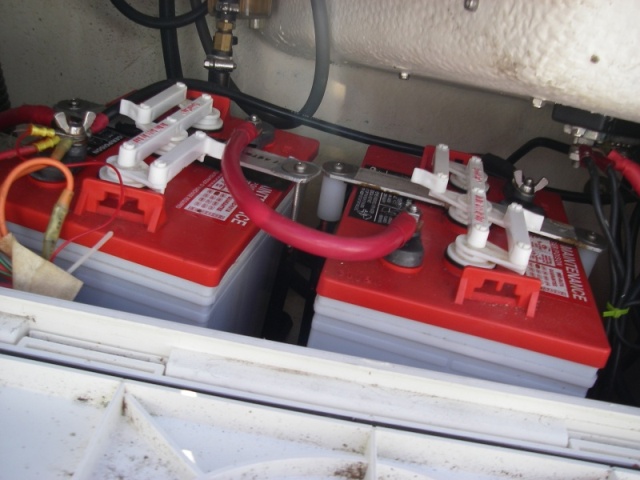
This image shows the way I modified the hold down to accommodate the new batteries. Cut the top off the hold down bolts, drilled a hole into the ends, and used a long bolt. The red ellipse shows the bolt and new strap. The black ellipse shows the 1 1/2" spacer.
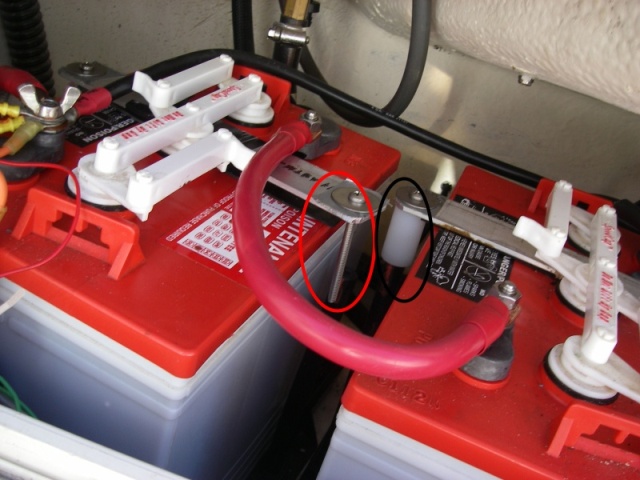
This picture shows how the battery switch and ground bus bar were relocated. Upside down on the bottom of the motor well. I also agree with keeping the grounds tight, and so I use a buss bar.
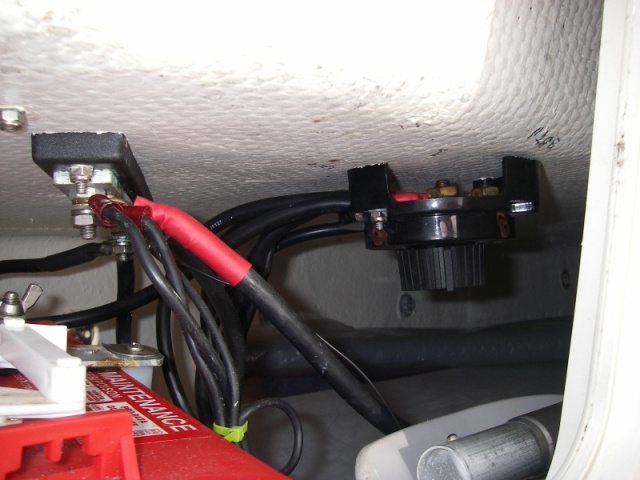
This picture shows the relocated backup battery (original factory) to give more room.
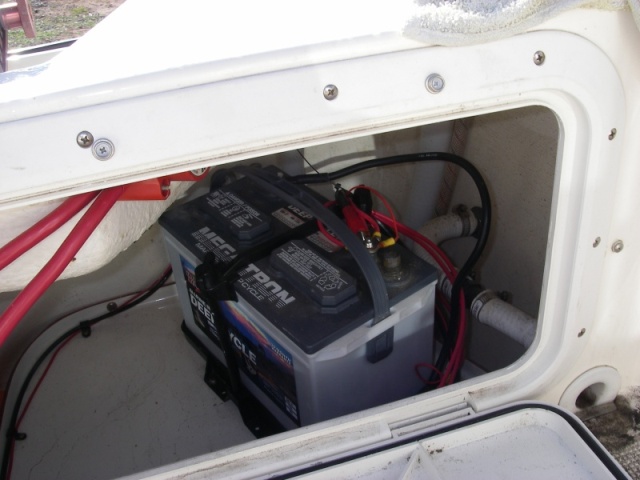
Here is the battery charger. It's hard wired into the main panel, in place of the factory battery charger, in the water heater cabinet. Put vents in the door to vent heat, and no problems yet. This is a Xantrex 3 stage, 40 amp total, but any good marine charger could be used. Any charger which comes with alligator clips or is a plug in type is not what I would use.
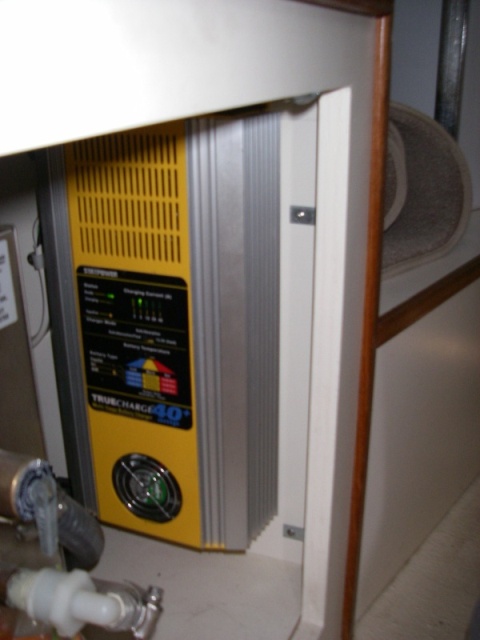
This shows the 10 ga wire connected from the battery charger outlet connector to the batteries (2 ea. positive and 1 ea. negative.)
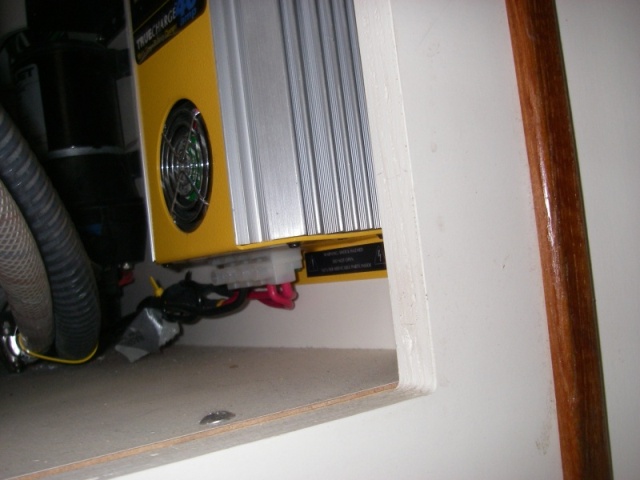
Boris |
|
| Back to top |
|
 |
Rob & Karen
Joined: 24 Nov 2006
Posts: 353
City/Region: Franklin
State or Province: TN
C-Dory Year: 2007
C-Dory Model: 22 Cruiser
Vessel Name: Life of Riley
Photos: Life of Riley
|
 Posted: Sun Dec 30, 2007 6:13 pm Post subject: Posted: Sun Dec 30, 2007 6:13 pm Post subject: |
 |
|
Hi Boris,
For the electrically challenged such as myself, what is the idea behind two positive leads and one negative lead per battery? I would have thought you would need the same amount of copper going to and from each battery.
Thanks,
Rob |
|
| Back to top |
|
 |
journey on
Joined: 03 Mar 2005
Posts: 3595
City/Region: Valley Centre
State or Province: CA
C-Dory Year: 2005
C-Dory Model: 25 Cruiser
Vessel Name: journey on
Photos: Journey On
|
 Posted: Sun Dec 30, 2007 7:19 pm Post subject: Posted: Sun Dec 30, 2007 7:19 pm Post subject: |
 |
|
Well, I'm not sure where you only got two positive leads to each battery. I should have used a terminal strip for each battery (but I didn't, and neither did the factory.) However, here's the best I can do:
Battery 1 (golf cart)
a positive wire at least to the following:
1. main battery switch (the one above the battery, which the factory installed and I moved.) This switches power from the engine and to the main DC panel between battery 1 & 2.
2. Inverter switch ( the two red cables above the backup battery lead to the inverter switch, so I can remove power from it.)
3. DC voltmeter, one for each battery.
4. Battery charger, one to each battery.
5. Wallas stove
6. Forward bilge pump.
Battery 2 (backup.)
As battery 1, except no inverter or Wallas, and aft bilge pump.
There is a single ground wire to each battery, (I hope and pray.)
Boris |
|
| Back to top |
|
 |
|
|
You cannot post new topics in this forum
You cannot reply to topics in this forum
You cannot edit your posts in this forum
You cannot delete your posts in this forum
You cannot vote in polls in this forum
You cannot attach files in this forum
You cannot download files in this forum
|
|

 Search
Search Private Messages
Private Messages Profile
Profile Log in
Log in Register
Register Help
Help














